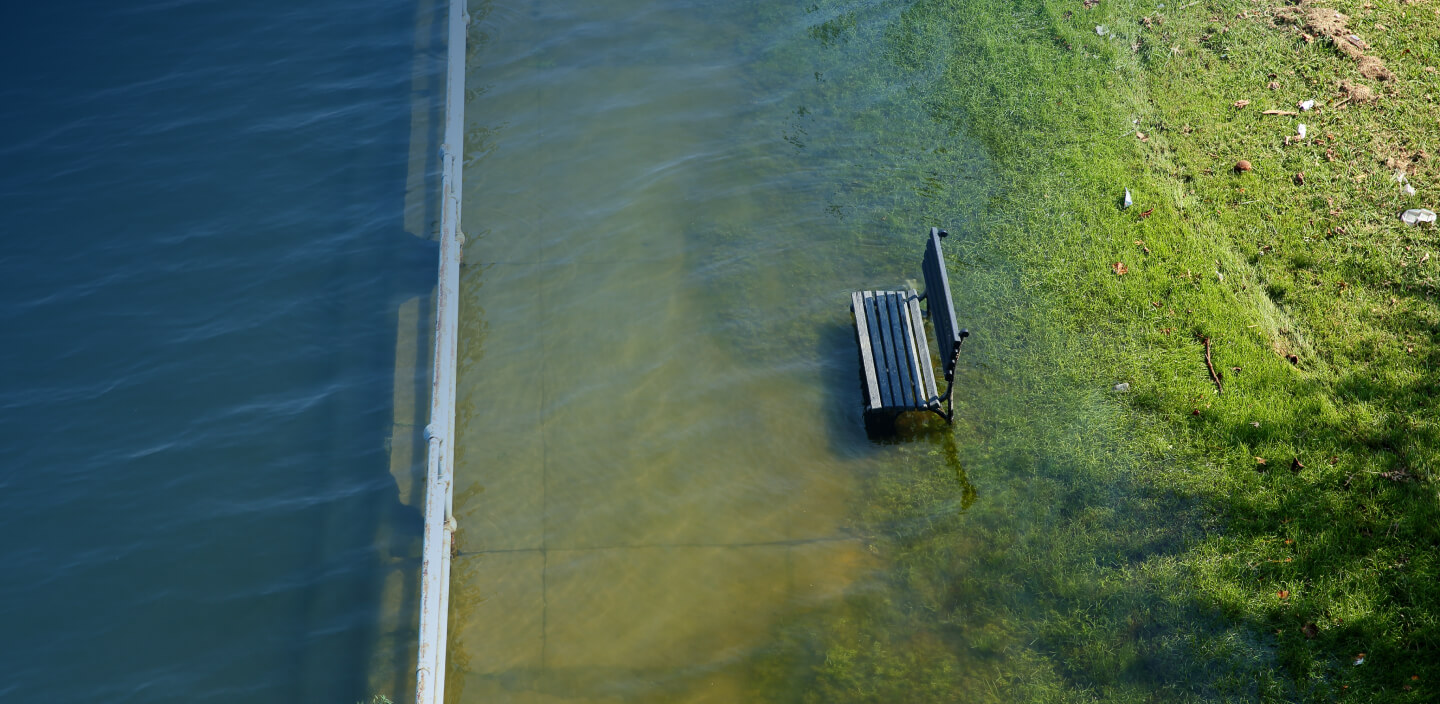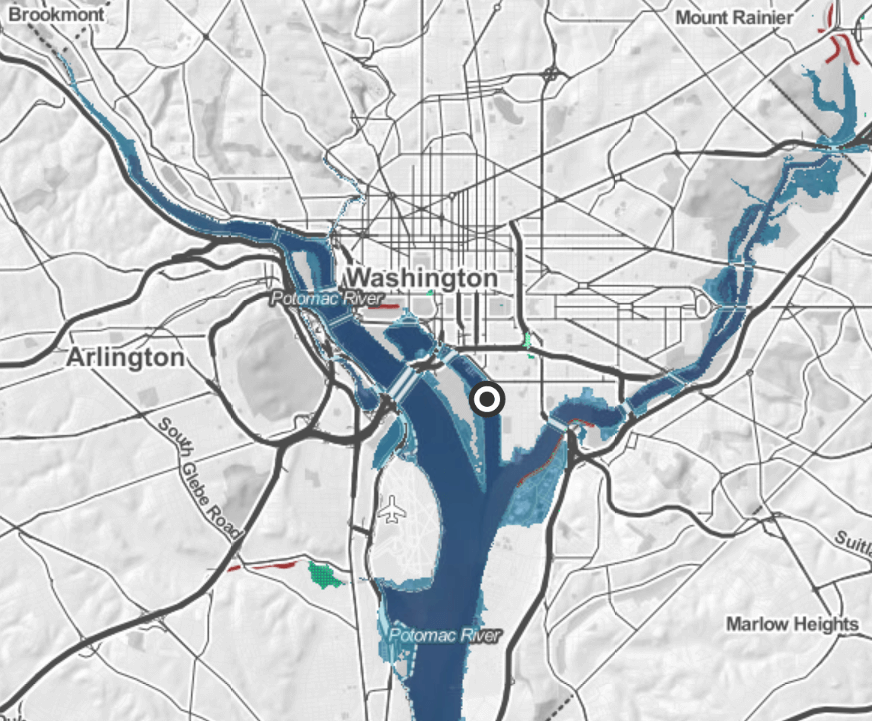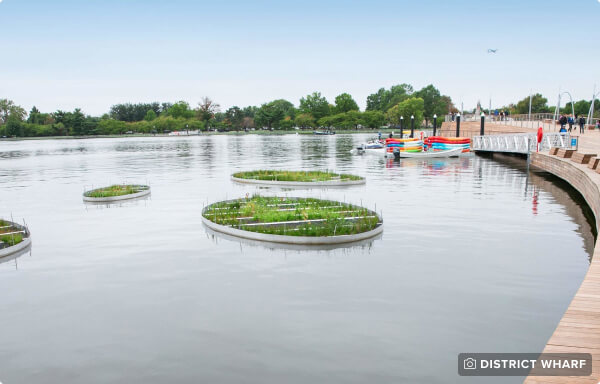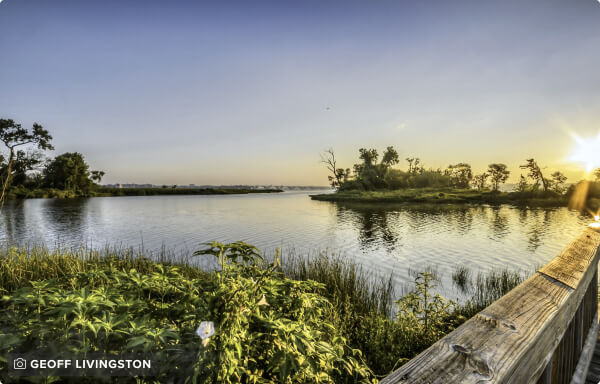

In Part One Global versus Local Climate Trends, we confronted the unpleasant consequences of the climate crisis: extreme heat and intensifying super storms are becoming normal in our new climate reality.
In the Potomac River region, flooding not only results from intense rainstorm events – like the one that gave rise to two tornadoes in the capital region on July 1, 2021 – but also from sea level rise.
“There’ll be a foot and a half of water, cars will be parked in it, halfway up their door. People walk by like it’s no big deal because they’ve gotten used to regular flooding.” Source
Global sea level rise is one of the clearest and most troubling impacts of the climate crisis.
The changing and heating climate is driving both the melting of glaciers and ice sheets, and the thermal expansion of seawater as it warms. Since 1880, the global average sea level has risen by 8-9 inches – and a third of that (about 2.8 inches) has occurred within the last twenty-five year.
The European Geosciences Union confirms that the Earth is losing 1.2 trillion tons of ice each year to heating trends – an increase of almost 60% since the 1990s. At this rate, global sea levels are projected to rise at least 1-2 feet by the end of the century.
Global sea levels rose by 8 inches since 1900 compared to 1.5 feet in Mid-Atlantic region. The Eastern US coast has averaged a rise of 12 inches in the same period of time.
The Potomac, a tidal river that flows into the more brackish waters of the Chesapeake Bay, has risen 11 inches in the last century, well above the global average.
Rising sea levels threaten every coastal community around the world, but our region has extra reason to worry.
In the US Mid-Atlantic region, rising waters from glacial melt combine with two unique phenomena that together, create a triple threat to our shoreline ecosystems and low-lying cities.
The changing climate is melting free floating sea ice in the Arctic Ocean and accelerating glacier retreat on Greenland. The resulting flow of freshwater into the ocean is slowing the Atlantic Gulf Stream. In turn, the slower ocean current no longer pulls water away from the US Eastern Seaboard as strongly as it once did.
The Gulf Stream is a powerful ocean current that originates in the Gulf of Mexico, bringing warm water up the entire length of the eastern U.S. seaboard, then sending it across the Atlantic to the waters surrounding the British Isles.
At up to 90 miles in width, it is sloped, with the (western) side closest to our coastline as much as five feet lower than its eastern, Europe-facing edge. When the Gulf Stream flows more slowly, the angle of the slope decreases and the water level on the Eastern coastline side rises, resulting in higher sea levels and increased flooding during high tides (Morrison, 2018).
The Potomac River and greater Chesapeake Bay region are expected to sink over six inches in the next 100 years, compounding the effects of sea level rise and a weakening Gulf Stream.
So, what exactly is causing our region to sink? A natural phenomenon – thousands of years in the making – called post-glacial rebound.
At the end of the last ice age, 11,000 years ago, massive glaciers and ice sheets began retreating from the surface of the Great Lakes region. These ice masses, which were miles thick, had pushed the Earth’s crust down into the upper mantle. Like a seesaw, the glaciers had weighted down the elevation of present-day Canada and parts of the northeastern United States, and subsequently raised the elevation of the Mid-Atlantic, including the coastal regions of the Chesapeake Bay.
Earth’s slowly-moving mantle is subsiding to its pre-ice age equilibrium level. As the land pushed down by glaciers are rising up, our region is sinking back down. And as the land beneath us sinks, the waters of the Potomac River and Chesapeake Bay rise above it.
The acceleration of sea level rise will dramatically change local shorelines in our lifetime and put low-lying areas at high risk for flooding and costly property damage.
Communities situated along the Potomac and its tidal streams will lose ground, businesses, and homes to the water’s advancing edge. Intruding saltwater will alter sensitive wetland and inland habitats.

Get an alert when we explore wildlife impacts in Part 4 later this summer!
In Part One of our climate series, we learned that intensifying storms are making flash floods more common in our area.
Less talked about, however, are dangers from two types of floods propelled by rising waters: higher high tides (sunny day flooding) and more powerful storm surges.
Sunny day flooding, also called nuisance flooding, can happen under perfectly clear skies. We’re experiencing this type of flooding more frequently because sea level rise is making high tides steadily higher. Our streamside infrastructure wasn't built with these higher tides in mind.
The shoreline community of Alexandria, Virginia is no stranger to sunny day flooding.
Jack Browand, acting Deputy Director of the Alexandria, VA Department of Recreation, Parks, and Cultural Activities, recalls the city’s biggest sunny day flood, “It was at the end of a 23-day dry spell here in Northern Virginia on a bright, sunny Saturday. We had a special event going on. There was a storm in the [Chesapeake] Bay that increased the level of the Potomac and the river hit four and a half feet. It flooded out the park and all the roads. We had to cancel the event.”
Between May 2018 and April 2019, Washington, DC was one of a dozen locations around the country that broke or tied their sunny day flooding records with 22 days. Along the Northeast Atlantic coast, sunny day floods increased by 100% - 150% in the last twenty years (Spiegel, 2019).
Storm surge occurs when wind gusts push water onshore causing a rise in water level above the normal predicted tide. The amplitude of a storm surge depends on the shoreline’s relationship to the storm track and the size, speed, and intensity of the storm.

According to local research from Climate Central, lower greenhouse gas emissions scenarios project flooding of over six feet above the Washington, D.C. high tide line in ten years ‒ a level exceeded only once within the past seven decades.
Six feet may not sound all that bad…until we consider just how much land is at stake.
Over 1,300 acres of Washington, DC – nearly the size of Rock Creek Park – lie below the predicted high tide line in 2030, including the Southwest, Greenway, and Foggy Bottom neighborhoods. This area represents $4.6 billion in property value with over 400 homes, 21 miles of road, two military facilities, one hospital, and 12 federally listed hazard sites, such as waste dumps and sewage plants (Strauss et al., 2014).

As reported in our 2020 Potomac River Report Card, record-setting rainfall in 2018 sent pollution levels soaring with disastrous short-term consequences for the Potomac River. The Potomac’s health declined for the first time in a decade – slipping from a grade of B to a B-.
Clearing forests and vegetated areas for streets, parking lots, and rooftops effectively strips the land’s ability to naturally absorb rainwater. With nowhere to go, excess stormwater carries fertilizers, toxins, litter, and other pollution over impervious surfaces directly into streams and sewers. Streambank erosion caused by flooding clouds waters and further pollutes waterways with excess sediment (the top pollutant to the Potomac River).
When we weaken our natural defenses, we’re making it that much harder to mitigate flooding – flooding that is set to get much worse due to sea level rise and more intense downpours.
Disregarding nature’s abilities to protect us has real costs – both to the health of our streams and drinking water sources and to taxpayers as massive infrastructure fixes, while effective, require exorbitant investment.
Sea level rise and stronger storm surges have been a wakeup call for shoreline communities – and encouragingly, many are taking action to create a safer, more resilient future.
It’s simple, really.
We can prepare our communities for the future and reduce pollution by working with nature, not against it. Here are 4 ways our community is driving change through nature-based solutions:
The District’s largest waterfront development project, The Wharf, was completed in 2017 with sea level rise in mind. Located on the Southwest DC waterfront, The Wharf has a gigantic underground cistern that traps floodwaters, and has raised water pumps and generators for electricity. The water can then be pumped to the top of buildings to power turbines, generating clean energy which helps reduce emissions. Projects like this can be a model of working responsibly with nature, but more needs to be done to ensure river-friendly and mixed-use neighborhoods are equitable and accessible to everyone in our community.

The historic Tidal Basin, which sits adjacent to the National Mall and on a 100-year flood plain, is slowly sinking and rising tidal waters aren’t helping. Flooded sidewalks, benches, and cherry trees are now as common of a sight as the flock of spring tourists. Six architects have partnered with the National Trust for Historic Preservation, the Trust for the National Mall, and the National Park Service to reimagine this beloved landscape with innovative restoration plans and restore living shorelines and ecosystems.
Since tropical storm Sandy raged through the Potomac River region in October of 2012, resiliency planning has been taken more seriously in legislative bodies. Following Maryland’s lead with its passage of the 2008 Living Shoreline Protection Act, Virginia enacted a VA Marine Resources Commission’s mandate to protect shorelines in 2020 and progress has been made at the local level to protect living shorelines from development. The City of Alexandria, Virginia and Montgomery County have embraced nature-based infrastructure in their long-term growth plans. And the District released a Resilient DC strategy to mitigate climate-driven flooding and control pollution.

The wetlands and forests of the Potomac River region are naturally designed to filter pollution, absorb excess rainwater, and prevent flooding. In fact, coastal wetlands are so effective at mitigating flooding it was found they prevented $625 million in property damage during Hurricane Sandy (2012). Protecting wetlands and investing in nature-based infrastructure are critical and affordable actions our communities can take to capture carbon naturally, prevent flooding, and protect rich ecological systems. An extensive project is underway to restore Dyke Marsh, a treasured local wetland that was nearly destroyed by nearby development.
People from all over the Potomac River region benefit from Mattawoman Creek, a peaceful oasis in fast-growing Charles County, Maryland. You'll find anglers catching leaping fish from boats and the shore. Egrets, herons, and bald eagles fish alongside them – there's plenty to go around. Paddlers flock here to weave their way through turtles sitting amongst fields of aquatic flowers.
And it’s a place with historical and contemporary cultural significance to the Piscataway people. The cultural history of the Piscataway may be woefully under documented, but they have been living off of, protecting, and accruing invaluable ecological knowledge about Mattawoman, its soils, wildlife, and waters for centuries. And they’re still here, watching the edges of this pristine place creep in.
In an act of shortsightedness regarding the climate crisis and the economic benefits that Mattawoman’s fisheries and recreation provide, the Charles County Planning Commission has proposed rezoning 558 of its protected acres to allow development of a small, private airport.
The airport expansion would not only pave over the habitat, flood protection, carbon sequestration, fisheries, and irreplaceable Indigenous cultural heritage on those acres – it would make flooding, water pollution, and climate change worse by constructing more impervious, heat-absorbing surfaces.
Stand with local communities who are fighting to protect Mattawoman Creek! Take Action Today!
Mattawoman Creek protects us from flooding, provides us with beauty and fish, and safeguards
deep cultural heritage. Now it’s time for us to preserve its past and future.
Will Parson/Chesapeake Bay Program
Fun fact: Scientists can identify increases in atmospheric carbon dioxide are, indeed, human-made because carbon created by burning fossil fuels has a different isotopic ratio of heavy-to-light carbon atoms than carbon produced naturally by living plants.
Fun fact: While carbon dioxide is the main culprit, other gasses like methane and nitrous oxide also add to the atmospheric soup of heat-trapping greenhouse gasses. Methane is released from natural gas fracking, the decay of organic waste put in landfills rather than composted, and from livestock and industrial agricultural practices. Nitrous oxide is released during fuel combustion and during the application of fossil-fuel based fertilizers or un-composted manure to fields (U.S. Environmental Protection Agency, 2020a).
In 2015, the ATMOS Research and Consulting for Kleinfelder published local climate projections by studying historic emission and temperature data at three District sites: Dalecaria Reservoir, the National Arboretum, and Washington National Airport.
Andrew Elmore co-authored a study on the warming waters of the Chesapeake Bay for the University of Maryland Center for Environmental Science.
Fun fact: Scientists can use high resolution climate models to tell whether an extreme event was made more likely by climate change – whether it served as a key ingredient in the storm’s formation. This is called “extreme event attribution.”
Fun fact: A rainfall event that is so heavy and unordinary that it only statistically happens once every 100 years
The National Weather Service confirmed an EF0 tornado touched down in Washington, DC and an EF1 tornado touched down Arlington, VA on Thursday, July 1, 2021. The nation’s capital has only experienced three confirmed tornadoes above an EF0 level in the last fifty years (two of which occurred on the same day in 2001).
FACT: According to the U.S. Geological Survey (USGS), glaciers and ice sheets store enough water to raise sea level by about 68 to 70 meters (223 to 230 feet) (Cronin, n.d.).
Thermal expansion is the phenomenon whereby the upper layer of the ocean absorbs heat from the warming atmosphere and expands
Over 400 miles in length, the Potomac River flows with fresh water from the highlands of West Virginia downstream to Washington, DC where it mixes with brackish saltwater and continues on to the Chesapeake Bay, the largest estuary in the world. The Potomac experiences daily low and high tides as far upstream as Washington, DC.
One such effort is underway in Washington, DC where tunnels are being constructed underneath the city’s rivers to divert excess rainwater and reduce sewer overflows into local streams. As part of the $2.7 billion Clean Rivers Project, DC Water has built a 5-mile long tunnel under the Anacostia River with plans to start building another one under the Potomac River in 2023. The plan also includes investments in tree plantings, rain gardens, and other types of nature-based infrastructure.
Living shorelines are a type of nature-based infrastructure that incorporates indigenous vegetation, either alone or in combination with harder materials for structure and stabilization. They restore ecosystems that naturally withstand and recover from the flooding that has become more common because of rising seas, stronger storms and heavier precipitation. Further, living shorelines build habitats that sequester, or store, carbon. According to NOAA, “one square mile of saltwater marsh stores the carbon equivalent of 76,000 gallons of gas annually.
Extreme heat conditions are defined as weather that is much hotter than average for a particular time and place—and sometimes more humid, too.
The heat index is a measure of how hot it feels when relative humidity is factored in with the actual air temperature. Relative humidity is the percentage of moisture in the air compared with the maximum amount of moisture the air can hold. Humidity is an important factor in how hot it feels because when humidity is high, water doesn’t evaporate as easily, so it’s harder for your body to cool off by sweating.
Ozone (O3) is a highly reactive gas composed of three oxygen atoms. It is both a natural and a man-made product that occurs in the Earth's upper atmosphere
(the stratosphere) and lower atmosphere (the troposphere). Depending on where it is in the atmosphere, ozone affects life on Earth in either good or bad ways.
Stratospheric ozone is formed naturally through the interaction of solar ultraviolet (UV) radiation with molecular oxygen (O2). The "ozone layer," approximately 6 through 30 miles above the Earth's surface, reduces the amount of harmful UV radiation reaching the Earth's surface.
Tropospheric or ground-level ozone – what we breathe – is formed primarily from photochemical reactions between two major classes of air pollutants, volatile organic compounds (VOC) and nitrogen oxides (NOx). These reactions have traditionally been viewed as depending upon the presence of heat and sunlight, resulting in higher ambient ozone concentrations in summer months.
Ground level ozone is a secondary byproduct of a chemical relation between human-made nitrogen oxides (NOx) and volatile organic compounds (VOCs) in the presence of sunlight. Humans are producing an extra 24 million tons of NOX annually through combustion processes from vehicles, power plants, cement factories (which are located adjacent to many communities of color in the Potomac River region), and other industry.
Nutrients—primarily nitrogen and phosphorus—are essential for the growth of all living organisms in aquatic ecosystems. However, excessive nitrogen and phosphorus degrade water quality.
Both nitrogen and phosphorus feed algal blooms that block sunlight to underwater grasses and suck up life supporting oxygen when they die and decompose. These resulting "dead zones" of low or no oxygen can stress and even kill fish and shellfish. Algal blooms can also trigger spikes in pH levels, stressing fish, and create conditions that spur the growth of parasites.
The incubation period is the number of days between when you're infected with something and when you might see symptoms. Health care professionals and government officials use this number to decide how long people need to stay away from others during an outbreak.
Coal ash, also referred to as coal combustion residuals or CCRs, is produced primarily from the burning of coal in coal-fired power plants.
Coal ash contains contaminants like mercury, cadmium and arsenic. Without proper management, these contaminants can pollute waterways, ground water, drinking water, and the air.
A Superfund site is an abandoned toxic waste site (usually that once supported an oil refinery or smelting or mining activities). In response to attention on sites like these in the late 1970s, Congress established the Comprehensive Environmental Response, Compensation and Liability Act (CERCLA) in 1980.
CERCLA is informally called Superfund. It allows EPA to clean up contaminated sites. It also forces the parties responsible for the contamination to either perform cleanups or reimburse the government for EPA-led cleanup work.
When there is no viable responsible party, Superfund gives EPA the funds and authority to clean up contaminated sites.
Frontline communities are those that experience “first and worst” the consequences of climate change. These are communities of color and low-income, whose neighborhoods will be increasingly vulnerable as our climate deteriorates.
Adaptive capacity is the ability of a habitat to support its species and ecosystem functioning as the climate changes. Plants and animals respond to changing climate by adapting, shifting their range, or fleeing completely.
Species that reproduce quickly are able to adapt or migrate more readily than slower growing, long-lived. species – like Maryland’s bald cypress that regularly lives up to 600 years.
Agriculture, development, and past logging operations played a large role in the large-scale loss of eastern hemlock throughout the Appalachian region.
Indigenous to East Asia, the fast-spreading hemlock woolly adelgid insect attaches to the soft, woody plant tissue and sucks nutrients from the sap of eastern hemlocks. Once the insect establishes a population on a hemlock, it can kill the tree within four years. Click on the link to read more about the pesky adelgid.
Coldwater streams make up approximately 2,750 miles of Maryland’s freshwater streams, spanning across Allegany, Garrett, Frederick, Carroll, Washington, Montgomery, and Prince George’s counties. In West Virginia, coldwater streams are found chiefly in the eastern panhandle. In Virginia, coldwater streams meander through the mountains and valleys of the Interstate 81 corridor, stretching across Augusta, Rockingham, Shenandoah, Warren, and Frederick counties up through Berkeley County in West Virginia.
Rainbow trout from the western U.S. and brown trout from Europe were introduced to the region in the late 1800s. They have slightly higher temperature tolerances and, once temperatures reach 68°F, they can out-compete indigenous brook trout. Elimination by competition is already occurring in some streams.
Fun fact: Salamanders are ectotherms, meaning they regulate their body temperatures through their environment. They sun themselves on rocks to warm up and cool off in streams or shaded areas.
Salamanders prefer temperatures between 33°F and 60°F. Their metabolism and heart rate slows when temperatures reach 50°F to survive more extreme conditions.
The opportunity to roam for resources is an important need for animals’ adaptive capacity in the fight against environmental changes.
NatureServe based its research on data from a weather station in Rock Creek Park and then used an ensemble of global climate models from the IPCC’s 5th Assessment Report to project near-future climate conditions in the Park.
In slightly salty oligohaline marshlands, salinity ranges from 0.5- 5 parts per thousand (ppt).
Visit Dyke Marsh or Mattawoman Creek to venture through two of our region’s freshwater marshes, areas of the Potomac River with salinity ranging from 0-0.5 parts per thousand (ppt).
According to a 2016 study in PLoS One, this edge might only be pushed up as far as Indian Head by the end of the century due to the region’s topography and the potential for water to spill out cross-sectionally (widening the river), rather than being pushed far upstream (Cadol et al., 2016).
Visit The American Scientist’s “Spring Budburst in a Changing Climate” for more information on how a warming climate is throwing off the timing of spring. The authors use Henry David Thoreau’s 160-year-old field notes to compare the timing of spring activities between then and now.
Roosevelt Island was transformed back into a “real forest” in the 1930s to mimic the natural ecosystems that covered the landscape before settler-colonial interference. Learn how this island has been transformed time and again – including how it was used as a place of refuge by people who were enslaved.
Source: University of Maryland Center for Environmental Science, 2015; Ding & Elmore, 2015.
www.umces.edu
The Maryland Commission on Climate Change, the Department of the Environment’s Scientific and Technical Working Group (STWG).
Source: “Understanding Virginia’s Vulnerability,” 2015
Every community produces polluted runoff – a type of pollution caused when excess rainwater carries toxins, debris, and litter into nearby streams – but the issue is particularly problematic on farmland. In fact, agricultural runoff is the greatest source of pollution to our region’s waterways. Poor land-use practices on farmland pollute streams with excess nutrients from fertilizers, pest treatments, and animal feces.
In 2018, the United States’ agricultural activity alone emitted approximately 698 million metric tons of greenhouse gasses into the atmosphere: 12.3% as carbon dioxide, 36.2% as methane, and 51% as nitrous oxide (U.S. Department of Agriculture, 2020).
Nitrous oxide is 298 times more potent than carbon dioxide over one hundred years, and is produced as microbes in the soil break down fossil-fuel based synthetic fertilizers and manure that hasn’t been aged or composted before being applied to fields.
Best management practices (BMPs) are conservation measures that improve land health and prevent or mitigate pollution through natural means. BMPs are critically important to restoring water quality in the Potomac River region. Potomac Conservancy helps connect area landowners to available resources to implement BMPs on residential properties with a focus on family-owned farms in the headwaters region.
Learn more at www.potomac.org/lands.
TEK refers to the ever-evolving wisdom gained by indigenous and locally rooted peoples over hundreds of years by means of direct contact with their environment. The U.S. Fish and Wildlife Service explains that, “this knowledge is specific to a location and includes the relationships between plants, animals, natural phenomena, landscapes, human beings, and timing of events that are used for lifeways,” like agriculture or hunting and trapping (Rinkevich et al., 2011).
Source (Aman & Pratt, 2014).
Industrial farming that relies on growing expansive fields of one crop – corn, wheat, soy, as examples – planted year after year, drain the soil of essential nutrients and lack the genetic diversity to fight diseases and pests. Consequently, they require the help of artificial additives.
The Lacandon are the last of the Mayans who escaped the Conquistadors’ forced Christianity by hiding in the heart of the jungle. For the last five hundred years, the Lacandon lived very simply and have kept their borders closed to outsiders. Their population consists of about six or seven hundred people now.
Earthaven Ecovillage is a permaculture community outside of Black Mountain, North Carolina that applies Traditional Ecological Knowledge.